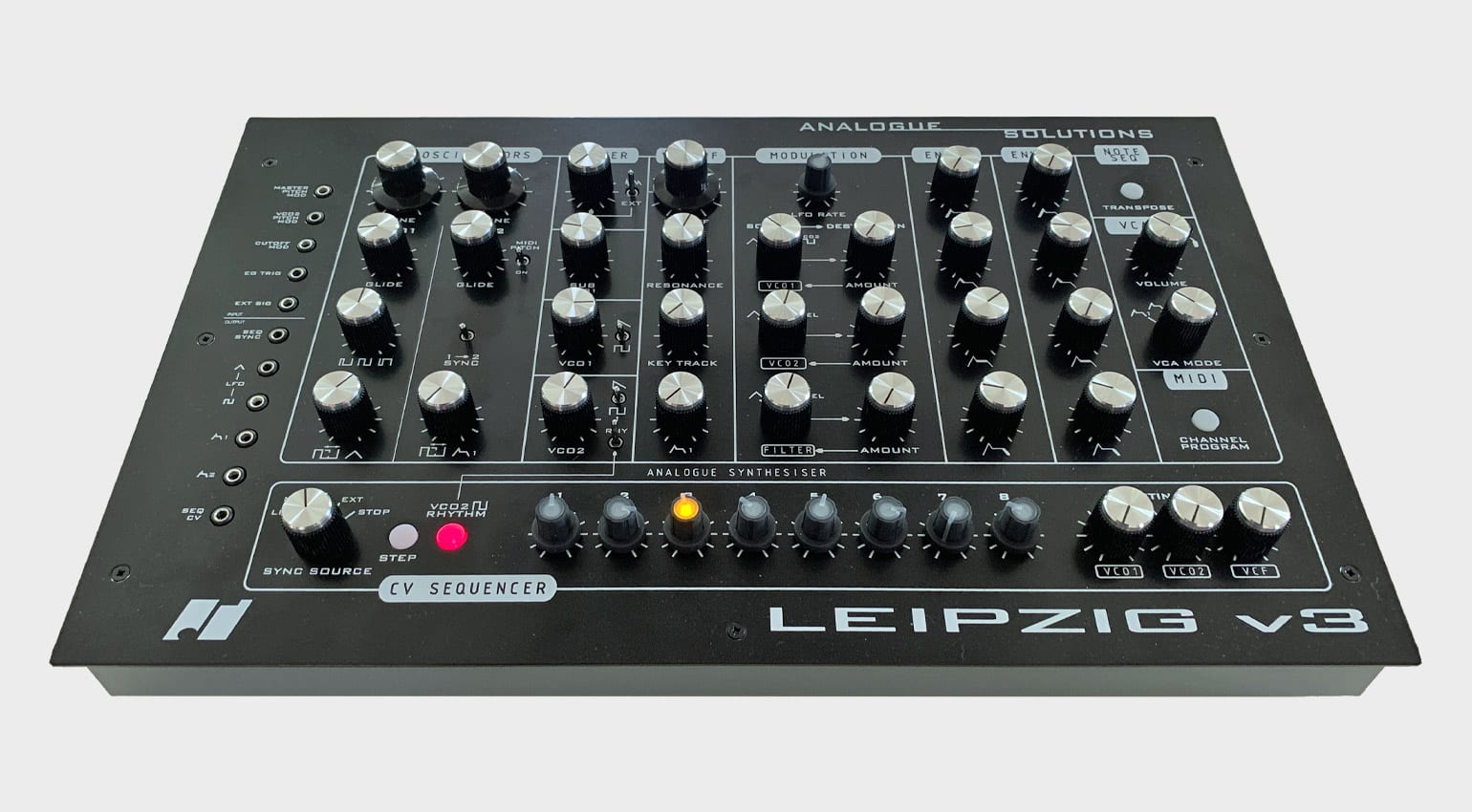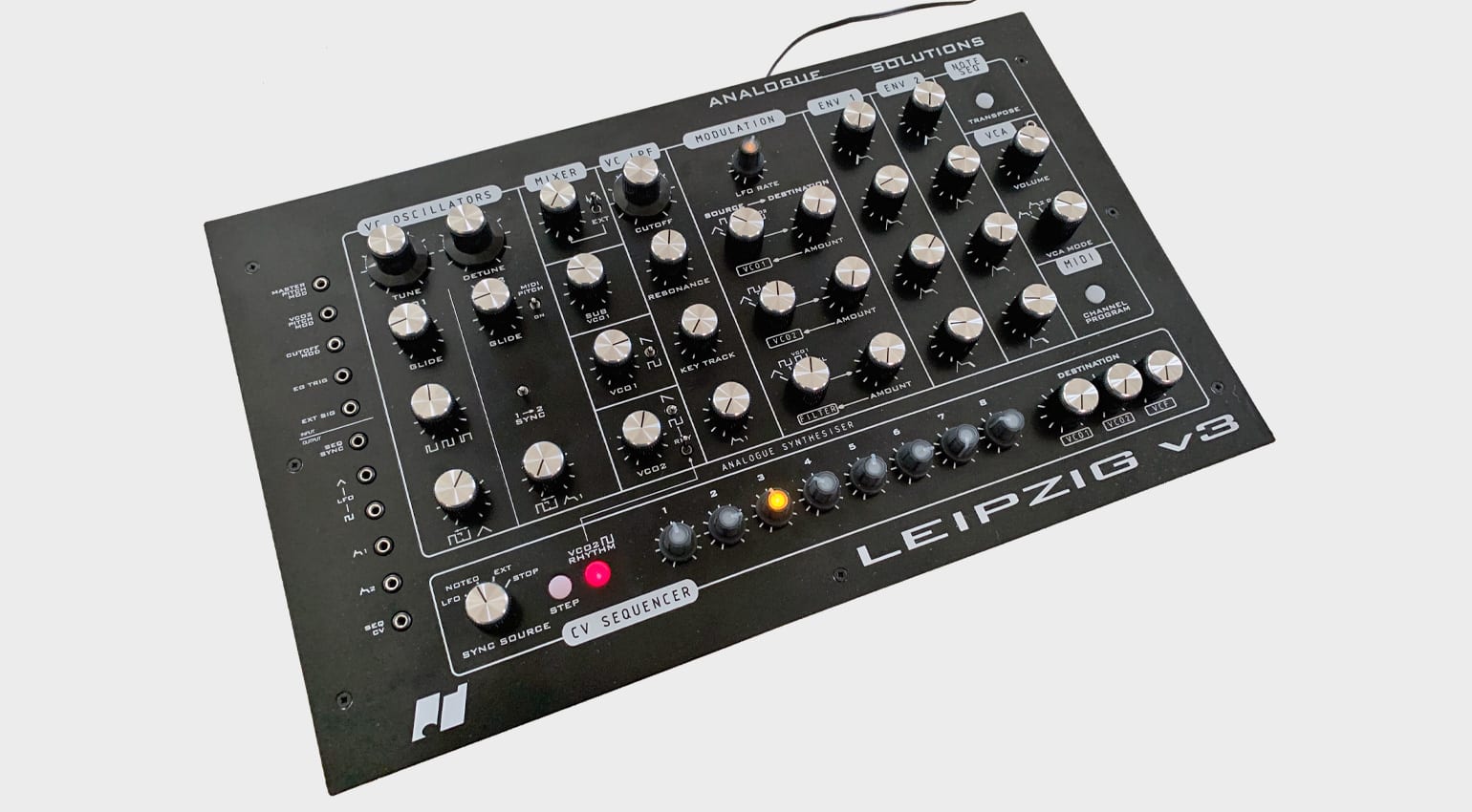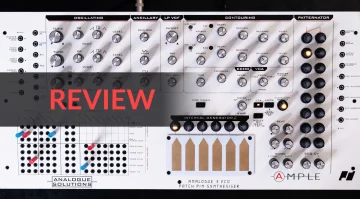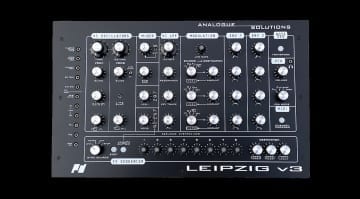First Look Review: Analogue Solutions Leipzig v3, analog in its purest form
The Analogue Solutions Leipzig v3 is the successor to the Leipzig-S, which came out about nine years ago. Like its predecessor, it’s a monophonic analog synthesizer par excellence: two oscillators, Moog-style ladder filter, VCA, LFO, two envelopes – that’s a tried-and-true formula for in-your-face basses, leads and sequences. Which tricks does the Analogue Solutions Leipzig v3 have up its sleeves that set it apart from the Leipzig-S? We’ve given the synth a good test run.
First look
Analogue Solutions is known for honest, straightforward analog synths that couldn’t care less about the latest trends. There’s no plastic, no miniaturization, no USB, no color LCD and no patch memory. Instead, the British manufacturer crafts synths that might as well have been conceived fifty years ago. So I was curious what Analogue Solutions has done to improve upon the Leipzig-S. Let’s find out!
Once out of the box, the Leipzig v3 immediately impresses with its comforting solidness. While the predecessor was designed to be mounted in a rack (which was already quickly falling out of fashion in 2012), this one’s a proper desktop synth with a sturdy, all-metal enclosure. There’s plenty of room for everything on the panel and the large knobs are a dream come true for anyone who doesn’t agree that smaller is always better. Each knob does exactly one thing, a principle which has been implemented in its purest form here. Still, there are a couple of things you can’t see, but more on that later.
On the back, the Leipzig v3 provides MIDI In and Thru, a mono audio output and a place to plug in the external power supply, along with a lighted power switch. There’s also an 1/8” headphone output, which can be found in the VCA section on the panel.
You are currently viewing a placeholder content from YouTube. To access the actual content, click the button below. Please note that doing so will share data with third-party providers.
Sound
The first glance at the panel reveals that the architecture remains largely unchanged. But there are a few adjustments. Like the Leipzig-S, the Leipzig v3 has a pretty straightforward signal path, which is also one of its biggest strengths. There are two VCOs with PWM and sync, one sub oscillator chained to VCO 1, a noise generator and a 24 dB low pass filter inspired by the classic Moog ladder. For modulation, you get an LFO, two ADSR envelopes and an 8-step CV sequencer, with a good number of ways to bring them into action. While the Leipzig v3 has quite a bit more to offer in the modulation department, this basic formula reminds me of some of the simpler Moogs like the Prodigy. And it’s an indication of its sonic strongholds: powerful, aggressive, in-your-face basses, leads and arpeggios are where the Leipzig really shines.
The screaming ladder filter takes a big share of the responsibility for the synth’s captivating punch. While it sounds great, it still exhibits a rather peculiar behavior that was sometimes criticized in the previous version. For about two thirds of the knob’s travel, the resonance control does very little. Turn it up a bit further, and the resonance increases suddenly and dramatically, which can be a bit hard to control. This, too, underlines the impression that showing restraint isn’t one of the Leipzig’s strengths.
So what’s changed? Not that much, actually. The Leipzig v3 offers switches for selecting the oscillator waveforms in the mixer section, as opposed to the bi-directional knobs on the Leipzig-S. The second sub oscillator has been axed, as has the ability to sync VCO 2 to the LFO or an external signal instead of VCO 1. Neither is a big deal in my opinion, but it’s a bit strange that the older version actually offered a bit more flexibility in this regard.
Other than that, everything remains the same. The LFO offers triangle and square shapes and can modulate the two oscillators and/or the filter cutoff frequency. VCO 1 can be modulated by VCO 2 (cross modulation), while VCO 1 can modulate the filter cutoff (filter FM). The two ADSR envelope generators can be routed to a good number of targets. You can choose which one of them controls the VCA. In addition, ENV 1 can also modulate the filter, VCO 1 pitch and VCO 2 pulse width, while ENV 2 can be used to control the pitch of VCO 2.
Patch points
The new patch points on the left give you even more flexibility. Besides the new sequencer features (more on that in a second), they are what really sets the Leipzig v3 apart from its predecessor. The Leipzig-S didn’t offer any CV/gate connectivity at all, which turned out to be a missed opportunity when the Eurorack boom hit with full force a few years later.
The Leipzig v3, on the other hand, gives you five inputs and six outputs to connect to your modular system, semi-modular synths or hardware sequencers. There are CV inputs for global pitch, VCO 2 pitch and filter cutoff. You also get a trigger input for the envelopes and an external input, which can be used to bring in an external audio signal or for clocking the internal sequencer. It’s important to note, however, that the pitch inputs aren’t calibrated to 1V/oct, so they’re not really suitable for note sequencing.
As far as outputs go, the Leipzig v3 gives you the sequencer sync signal, both LFO waveforms and both envelopes. There’s also an output for the integrated CV sequencer, which means that you can use it to drive things in your Eurorack or elsewhere. Nice!
Compared to many semi-modular synths, the Leipzig’s patch capabilities are still pretty basic. But you get all the essential connections for combining the synth with other gear in meaningful ways, which is a big step forward compared to the Leipzig-S.
Sequencer
At first glance, the sequencer looks almost exactly the same as on the previous version. But this is where some of the biggest changes are hidden – and I’m not quite sure what to make of some of the new stuff. The Leipzig-S had a simple, but very useful CV sequencer with eight steps, which could be triggered by a variety of sources (including VCO 2). In the new version, some of it remains the same, some had to go and some new things were introduced.
What you see on the panel is the 8-step CV sequencer, which works mostly the same as on the Leipzig-S. It can modulate VCO 1, VCO 2 and the filter, controlled by three separate pots. Because the sequencer lets you address VCO 2 separately, it’s great in combination with the oscillator sync feature, for example. Sadly, though, Analogue Solutions has taken away some of the trigger methods. The sequencer can sync to the internal LFO, incoming MIDI note events with a value of zero or an external signal coming in via the EXT IN jack. But several trigger options of the Leipzig-S are no longer available, including VCO 2 and a couple of MIDI options.
On the other hand, there’s a very cool new feature called VCO 2 Rhythm, which can be thought of as a kind of accent. It can only be used with the pulse waveform of VCO 2. Once activated, you can program a rhythm for VCO 2 in the sequencer and the oscillator will only play on the active steps, which allows you to create interesting patterns in combination with VCO 1. This is a feature I really enjoyed.
MIDI note sequencer
The most important new feature, however, isn’t visible on the panel. In addition to the 8-step CV sequencer, the Leipzig v3 offers a second sequencer, which works in the MIDI domain. It remembers the last 16 MIDI notes played, and plays them in a continuous loop in parallel with the CV sequencer.
In practice, I had a bit of a hard time getting used to this feature. Not only is it impossible to deactivate the MIDI note sequencer, but you also cannot delete the notes from the memory. The only way to create a new pattern is to send 16 new notes to the synth via MIDI. Anytime the CV sequencer runs, the note sequencer also runs. If you’d like to use the CV sequencer to drive the oscillators and sequence notes, you have no choice but to “neutralize” the MIDI note sequencer by entering 16 identical notes.
I’m sure this has its uses as a performance feature, as you constantly end up with new patterns by adding a bunch of new notes. On the whole, though, I didn’t find it to be practical, or I maybe just failed to see the point. I’m sure Analogue Solutions had something in mind when they added this feature. But I would have preferred to be able to turn off the MIDI note sequencer, as it effectively prevents you from using the CV sequencer for modulation without a MIDI sequence running at the same time.
Conclusion
The Analogue Solutions Leipzig v3 is a refreshingly direct, down-to-earth analogue synth with a bold and gritty sound, which lends itself well to more aggressive styles. The sturdy desktop enclosure has a more practical form factor than the predecessor’s rack mount chassis, and the straightforward architecture and generously large knobs make tweaking a highly enjoyable experience. Despite its relative simplicity, the Leipzig v3 offers many ways to get creative, thanks to its modulation capabilities and the integrated 8-step CV sequencer. However, the newly added MIDI note sequencer feels a bit like a half-baked afterthought in its present form.
The Analogue Solutions Leipzig v3 is available from Thomann.de* for €1179.
More information
- Analogue Solutions website
- More from Analogue Solutions
Videos
You are currently viewing a placeholder content from YouTube. To access the actual content, click the button below. Please note that doing so will share data with third-party providers.
You are currently viewing a placeholder content from YouTube. To access the actual content, click the button below. Please note that doing so will share data with third-party providers.












